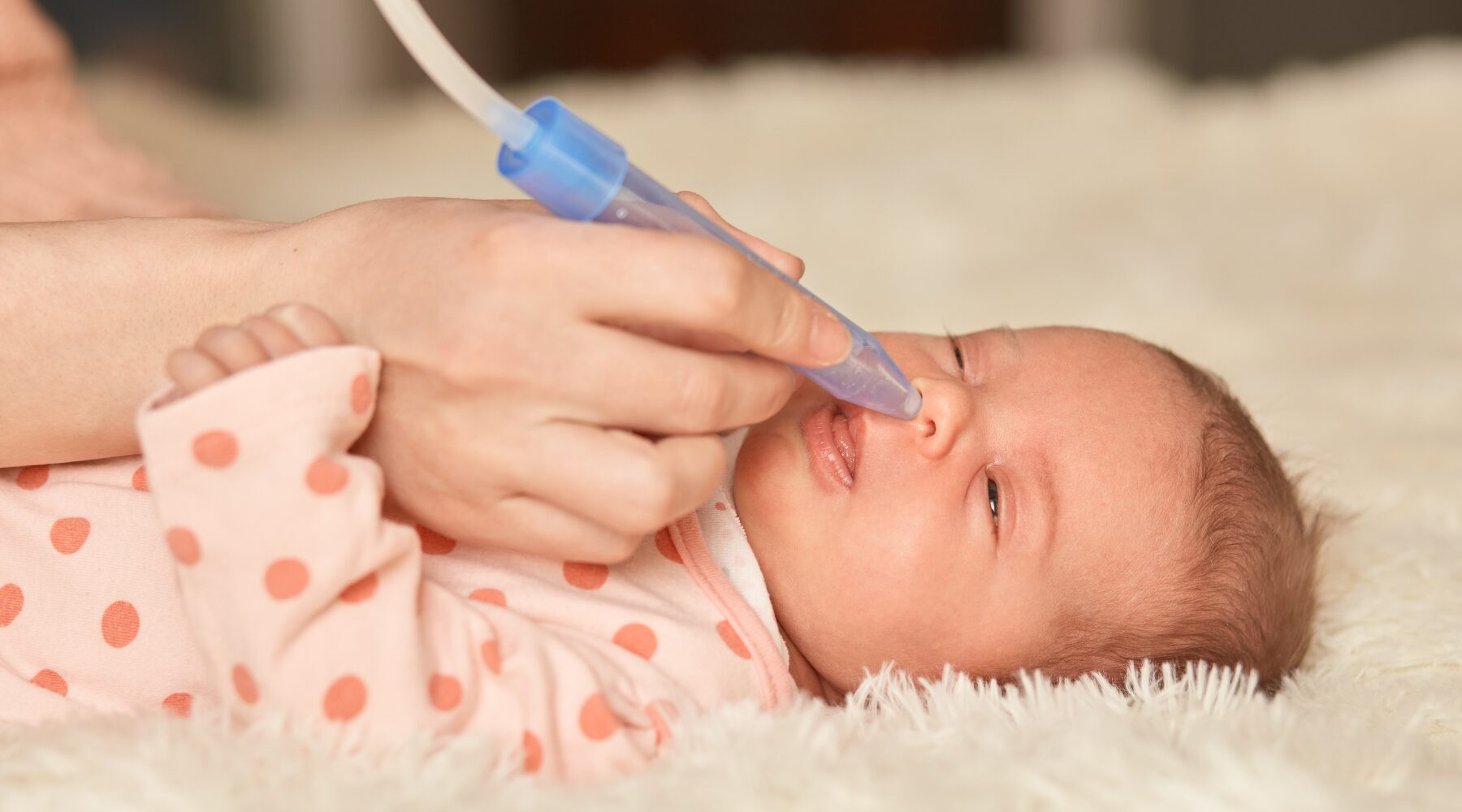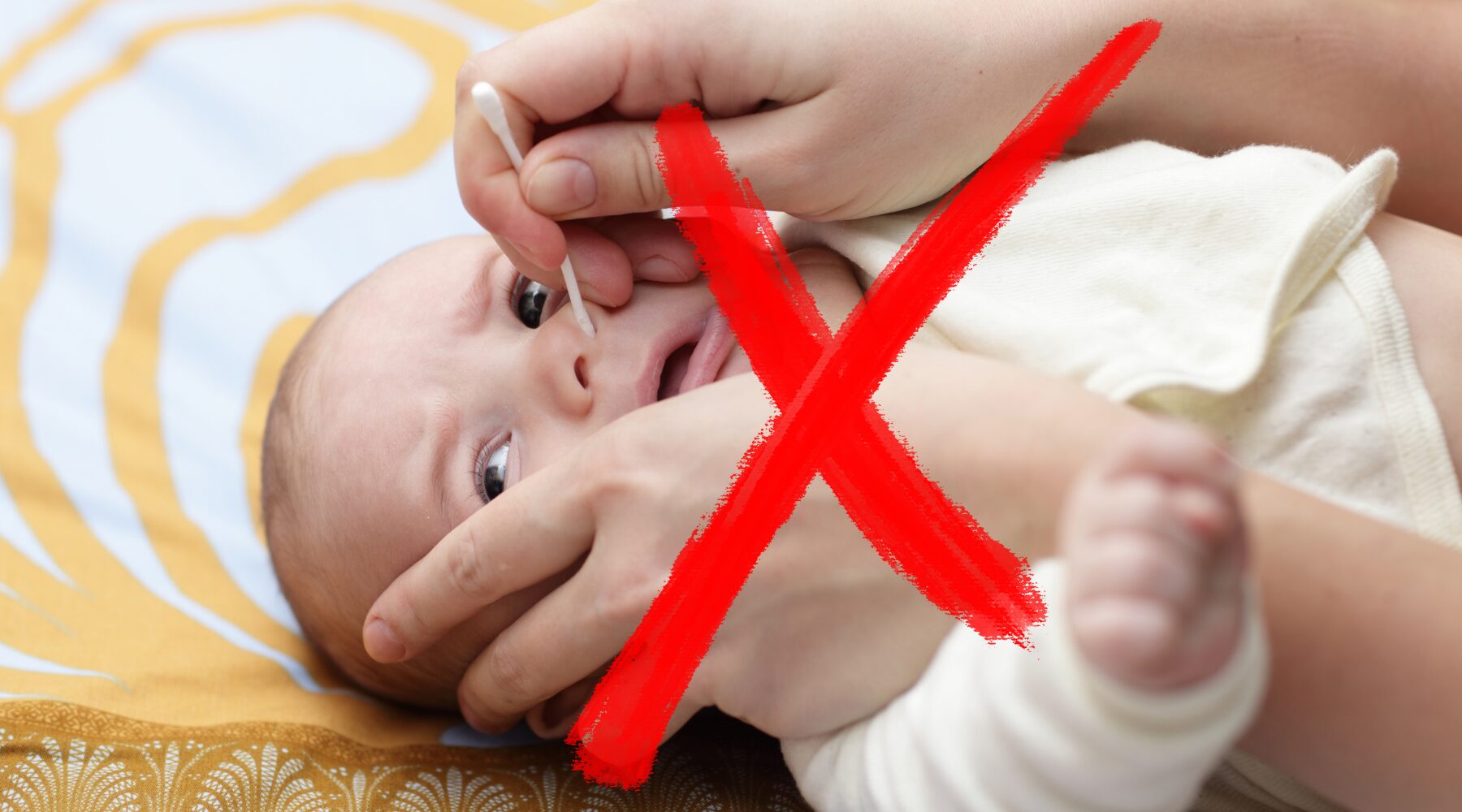
In this blog, I’ll walk you through the causes and implications of baby nasal congestion – signs to look out for, when you need to seek help and simple – yet effective – ways to treat your little snotty monster!
Did you know babies should only breathe through their noses?
Newborns are obligate nose breathers, meaning they primarily breathe through… you guessed it, their noses!
Most parents are shocked that babies don’t breathe through their mouths until they are closer to 12 months – that’s why nasal congestion can be really concerning, especially when it impacts feeding at the breast or bottle.
Because of this – they often sound like a Mr Snuffleupagus – not as cute as it sounds – the snorting and gurgling can be cause for concern and also incredibly distressing for parents.
Understanding newborn congestion
Due to the nasal passages being small and therefore prone to congestion, three problems quickly emerge:
- Breathing can be impaired;
- It can quickly impact feeding and
- It can lead to sleep disturbances and general fussiness.
So there’s good reason to be concerned about your baby’s stuffy nose.
Not all snot is bad – snot is actually great
When not associated with an upper airway infection, snot is terrific; it lines the nose and acts as a slimy, sticky layer to keep dust, bacteria and anything else from entering the lower airways.
It’s the build up of mucus, congestion and associated symptoms that’s the problem.
Causes of newborn congestion
Understanding what causes newborn congestion can help you find the best ways to alleviate the discomfort.
These are the top 3 causes of excessive newborn congestion – colds and viruses are by far the most common cause:
- Colds and respiratory infections:
Newborns have developing immune systems, making them susceptible to colds and respiratory infections.
This can lead to an increase in mucous production and congestion, making it harder for your baby to breathe nasally. - Environmental factors:
Dust, pet dander, and other allergens in the air can irritate your baby’s nose, leading to congestion. - Dry air:
Dry air can irritate your baby’s nose, leading to congestion. This is especially common during the winter months when heating systems are in use.
The symptoms of nasal congestion include:
- Runny nose (rhinorrhoea)
- Sniffling
- Noisy or fast breathing
- Snoring
- Sneezing (this is actually your baby’s natural way of clearing the mucus)
- Coughing
- …and the associated impacts of poor feeding – dehydration, fussiness and poor sleep
How to safely clear a newborn’s congested nose
You can clear a newborn’s congested nose to help your baby breathe, using gentle and safe techniques. Here are my recommendations:
- Salt water nose drops:
Saline drops can help loosen the mucus in your baby’s nose, making it easier to clear – you can use specialised drops or just plain old saline solution from the chemist and use a small syringe to drop them in.
Lay your baby on their back and gently squeeze a few drops of saline solution into each nostril.
Wait for a few moments, and then use a bulb syringe to suction out the loosened mucus.
Once they are bigger you can use saline sprays. - Bulb syringe suction
A bulb syringe can be used to suction out the mucus from your baby’s nose.
Squeeze the bulb, gently insert the tip into your baby’s nostril, create a good seal and release the bulb to deliver suction.
Be careful not to insert the syringe too far into your baby’s nose or suction too forcefully.
I personally find these aren’t as effective as nasal aspirators (see below) but they are better than nothing.
NOTE: Snot sucking will be one of the most disgustingly enjoyable things you’ll do as a parent!
-
Nasal aspirators – AKA SNOT SUCKERS!
These devices help by removing excess mucus from your baby’s nose and use prolonged suction to clear the nasal passages.
There are electric versions or ones where you use your own mouth to literally ‘suck the snot’ out of the nose…if you’re like me, you’ll like the one that uses your own mouth for better control, but the electric ones are great too.
As a paediatrician, I can’t recommend specific pharmaceuticals or medical devices but every family with a baby needs saline and a snot sucking aspirator of some description in their baby kit.
If your baby is congested, I recommend you use saline and an aspirator before every feed and before you put them down to sleep.

Other remedies to relieve newborn congestion
- Steamy bathroom: Create a steamy environment in your bathroom by running a hot shower. Sit in the bathroom with your baby for a few minutes to help loosen the mucus in their nose.
- Humidifier: Using a humidifier in your baby’s room can add moisture to the air and help relieve congestion. Ensure that the humidifier is placed at a safe distance from your baby’s crib to prevent any accidents. Don’t add essential oils.
- Give your baby a gentle face massage: Very gently massage your baby’s face – down their eyebrows, cheek bones, nose and temples – this can help warm and release mucous – plus your physical touch is highly comforting
It’s important to note that natural remedies may not work for every baby and consulting with your GP or paediatrician is always recommended.
How to Help Your Congested Baby Sleep
When your newborn is congested, it can disrupt their sleep and make them fussy.
Here are some tips to help your congested newborn sleep better and clear nasal congestion:
- Saline nose drops & an aspirator: Administering nasal saline drops and using a snot sucking device before bedtime can help clear your baby’s nose, allowing them to breathe more easily while they sleep.
- Use a cool-mist humidifier: A cool-mist humidifier in your baby’s room can help keep the air moist, reducing congestion and promoting better sleep.
- Elevated sleeping position: Place a rolled-up towel or blanket under the head of their mattress to create a slight incline.
This third remedy is often recommended – but is highly contentious…
While elevation does help with congestion as a National Red Nose/Safe Sleep Ambassador, I’m more than aware this creates an unsafe sleeping situation as it creates an environment where your baby can roll into unsafe positions. This should only be used if your baby is being monitored for the entire sleep.
This is NOT recommended for unsupervised sleep. The American Academy of Paediatrics, The Red Nose Foundation and relevant research confirm that a firm, flat surface is the only safe option for unsupervised sleep even if your baby is sick/congested.
When to seek medical help for nasal congestion
While newborn congestion is common and usually resolves on its own, there are instances where medical help may be necessary.
You should consult your GP or paediatrician if:
- Persistent symptoms: If the congestion persists for more than 10-14 days without any sign of improvement. This could indicate an underlying issue that needs medical attention.
- Fever: If your baby develops a fever, especially if they are less than 3 months old. A fever in a newborn can be a sign of a more serious infection.
- Difficulty in feeding or sleeping: If congestion is causing significant difficulty in feeding, leading to poor weight gain, or if your baby is having a lot of trouble sleeping.
- Dehydration: A baby that is fussy and isn’t feeding can quickly become dehydrated. Signs your baby is dehydrated are dry nappies, no tears when crying, dry mouth, sunken eyes, a sunken fontanelle and general lethargy.
- Breathing difficulties: If your baby is having significant trouble breathing or showing signs laboured breathing, such as flaring nostrils, grunting, or their chest and neck seems to be retracting with each breath.
- Breathing faster than normal: Babies already breathe quite fast… 40 breaths per minute, as adults we take about 12-20 breaths per minute. If your baby is taking more than 60 breaths per minute or appears to have trouble catching their breath, you should call an ambulance.
- High pitched sounds: normal nasal congestion is associated with lower gurgles, high pitched/squeaky sounds can be caused by a condition called laryngomalacia (discuss this with your baby’s doctor). It could also be a sign of croup. I recommend all high pitched sounds be reviewed.
- Change in skin colour: If you notice any change in your baby’s skin colour, like bluish tint around lips, fingers, or toes, this can indicate a lack of oxygen.
- Unusual crying or irritability: If your baby is unusually fussy, crying more than usual, or seems to be in discomfort, this could be a sign that the congestion is causing significant distress.
- Chest congestion: if you can hear or feel chest congestion, always have this reviewed.
- Other symptoms: If congestion is accompanied by other symptoms like a severe cough, vomiting, or diarrhoea.
- Parental instinct: if there’s anything that seems off about your baby that is making you concerned – a parent’s instinct is seldom wrong.
How long does nasal congestion in babies last?
Congestion often resolves within 10-14 days. If your baby’s congestion persists for more than two weeks or is accompanied by other concerning symptoms, such as a high fever, significant chestiness or difficulty breathing, seek medical advice. The cough will often last longer than a runny nose if your baby has that symptom as well. As discussed above, it’s best to always consult your baby’s healthcare provider if your little one has a cough or fever, especially if younger than 3 months old.
Preventing your baby’s nose congestion in the future
While it may not be possible to prevent newborn congestion entirely, there are steps you can take to minimise its occurrence:
- Maintain a clean environment: Regularly dust and vacuum your home to reduce allergens that can trigger congestion. Never allow babies or children to be exposed to cigarette smoke.
- Use a humidifier: Using a humidifier in your baby’s room can help maintain optimal humidity levels and prevent dry air that can irritate their nose.
- Avoid exposure to sick individuals: Limit your baby’s exposure to individuals who are sick or have respiratory infections to reduce the risk of contracting viruses that can lead to congestion. One of the top tips in my book “Your Baby Doesn’t Come with a Book” is to send a text out to your friends and family when your baby arrives, discussing expectations on vaccinations and being well if they drop in.
Avoiding exposure from symptomatic adults is pretty straight forward – it’s easier said than done if you have older siblings at childcare in the house – my recommendation here is to be militant around hand hygiene and practise physical-distancing if an older sibling is sick.
By implementing these preventive measures, you can reduce the frequency and severity of newborn congestion.
What not to do when it comes to nasal congestion?

- Don’t stick a cotton bud up your baby’s nose to try and clear the mucus out: if there is snot up there, allow it to be gently removed with saline and an aspirator, if your baby has had a viral swab you’ll know this can led to bleeding and discomfort, so avoid if possible.
- Do not use medication, essential oils or vapor rubs: most over-the-counter cold medications are not safe or effective for babies. Vapour rubs (often containing menthol, eucalyptus, or camphor) are proven to be dangerous for children younger than 2.
With the right care and attention, you can help your congested newborn feed well, sleep better and thrive as they recover from whatever lurgy they have caught along the way.
Remember, it’s always better to err on the side of caution when it comes to your baby’s health, particularly newborns. If you’re concerned about your baby’s nasal congestion, get your child’s healthcare provider to take a look.



